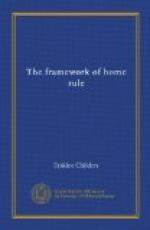In Lower Canada the same preposterous system of government was aggravated by the presence of the two races, French and English. Yet there was nothing inherently dangerous or unwholesome about this situation. The French, like the Catholics in Ireland, never showed the smallest tendency towards religious intolerance, nor were they less loyal at heart than the Radicals of Upper Canada or the Tories of either Province. They took the same energetic part in repelling the American invasion of 1812, and produced at least one remarkable leader in the person of Colonel Salaberry, who commanded the French-Canadian Voltigeurs. Like their co-religionists in Ireland, they were temperamentally averse to Republicanism in any shape, whether on the American model over the border or on the model of revolutionary France, where Republicanism since 1793 was anti-Catholic and the result of miseries and oppressions as bad as those in Ireland; whence, moreover, many priests and nobles fled from persecution to Lower Canada. As in eighteenth-century Ireland, we find that the Roman Catholic clergy, the seigneurs or aristocrats, and the habitants or peasants, were of a Conservative cast, throwing their weight, often even against their own interests, into the scale of the established Government, while the lawyers and journalists alone produced determined agitators. The racial cleavage, moreover, as in Ireland, was artificially accentuated by the political system. There was in reality a strong community of interest between the British lower class and the French lower class against the tyranny of an official clique, and to the end a substantial number of Englishmen worked with the French for reform; but with the failure of their efforts came that inevitable tightening of the bonds of race, even against interest, which we have seen operating with such lamentable effect in Ireland. And, as in Ireland, we find the best instincts of the people withered and perverted into rebellion by “Fitzgibbonism,” the policy of distrust and coercion.
The British official ascendancy, supreme from the first, became extraordinarily rigid. The Executive Council and Legislative Council were almost entirely British, the Assembly overwhelmingly French. There were no regular heads of departments, so that the Governor had no skilled advice, much less responsible advice. The Councils blocked all legislation they disliked, and for more than forty years, by means of unrestricted control over a large part of the provincial revenues, were able to defy the Assembly. It will be observed that, although Ireland never had anything worth calling an Assembly, her structure both before and after the Union was essentially the same, in that Irish public opinion, whether voiced by the Volunteers against the unreformed Parliament or after the Union by the Nationalist party at Westminster, was powerless. The existence of a popular Assembly in Canada only made the anomalies more obvious.




